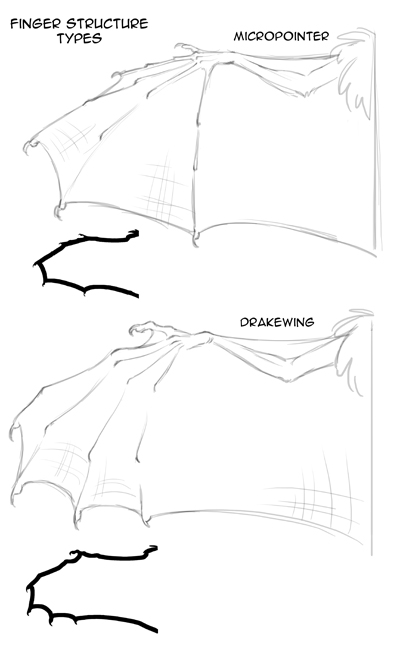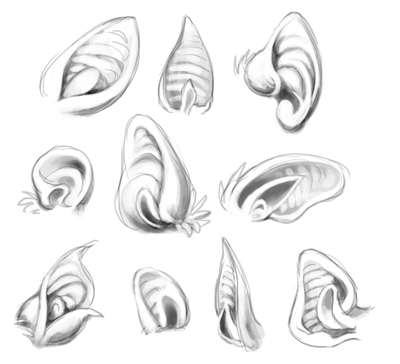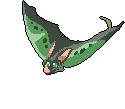| |||||||||||||||||||
Overview
One of four intelligent races that have evolved on an ancient homeworld of the Kamir - once known as Kamm Shohob, now known as Kamsho. All four races on Kamsho are creations of the Kamir. Tupai adults average about two feet in height, bipedal with two arms with leathery skin flaps that expand to serve as wings, two squat legs, and a sinuous tail. They have blunt, pug-like snouts and shiny black compound eye clusters. Their fur ranges from dark green to gray.
Physical Data
As with personality, body types vary widely, but still follow the basic structure of a fleshy, upright nose, large ears, green-gray fur, a slender tail, compound eyes and leathery wings.Wings
There are two major wing structure types: Micropointers and Drakewings. This is akin to how some humans are born double-jointed and others are not. Drakewings are the norm, and Micropointers are a little rare.
Micropointer wings have a thumb free from membrane and a very short index/pointer digit, thus the name micropointer. Their fifth digit (or pinky) points straight down when the wing is stretched. Micropointer Tupai are often swifter than Drakewing Tupai.
Drakewings have membraned thumbs with digits of equal length. The membrane is a bit more broader which makes for better maneuverability compared to Micropointers. With muscular digits, Drakewing Tupai are considered to be powerful fliers that are capable of lifting several times their own weight.
Eyes
Tupai eyes are compound and very similiar to insects. While the base color is black, they have an iridescent sheen that causes colors at different angles. Sight is divided into multiple facets, so Tupai, like insects, see many versions of the same thing.
Ears
The ears come in many different shapes though very often they're as tall as the head itself if not taller.
Noses
Tupai snouts are always pressed inward and never narrow (like a fruit bat). Like their ears, the noses (or noseleaf) are highly sensitive to not just scent but sound and vibrations.
Diet
Tupai are omnivores, but prefer live insects when they can get them. They're also partial to fruits and occasionally vegetables, but do not drink blood, contrary to the popular Terran assumption.
Behavior
Like many sentient species, Tupai behavior varies from subject to subject. Personality-wise, they tend to be on the humble side, at least around their employers. Tupai have a great passion for flight, having created several airborn games involving skills in banking, diving and maneuvering. Many feel most comfortable in dark conditions. Some Tupai enjoy perching on shoulders; the farther away from the ground they are, the happier. A scratch behind the ears is considered the utmost type of praise from a Llivori. Not unlike Earthen bats, Tupai sleep hanging upside down and rarely any other way.
Tupai are capable of echolocation ie. sending high-pitched 'pings' to bounce off of unseen objects to help locate things or fly at night.
History
The Kamir created the Tupai to work as servants in their grand palaces on Kamm Shohob, Aukam, and elsewhere throughout Hiverspace. After the exodus of the Kamir, however, the Tupai were without masters. They became absorbed primarily into the cultural landscape of the Llivori, who employ them as inexpensive labor. Higher-paid Tupai are put to use as spies, often conducting aerial surveillance and other covert operations against the Opodians.
Culture
Most all Tupai are tasked with cheap labor, trivial tasks, or servant work. Higher paid Tupai work as spies for anti-Opodian organizations. They work under a variety of Hiverspace races, though they are most loyal to Llivori.
Tupai inherently lack senses of leadership and control, and are most content when they are led, which makes them perfect for the subservient role in their society. For whatever reason, they are convinced they cannot fend for themselves, and thus must find an employer if they are not born into a job. Many feel that they cannot function without a task from a Llivori. Some admit that they're afraid of doing anything else. Others believe that they are doomed to fail in whatever other endeavors they may want to try.
There are few things more important to a Tupai than employment, especially by a Llivori. Social status depends greatly on this; an unemployed Tupai is a great rarity. Tupai often hold multiple jobs, as a safety net - getting fired can mean death in many cases.
Tupai are very dependent on their employers, who often supply room and board. They literally live to work, and the Llivori are aware of their laborious nature. This has led to a steady decrease in pay, poor, work conditions, and very little breaks or time off, if any at all - not necessarily out of cruelty. In fact, Tupai are known for their steadfast loyalty to their employers, and Llivori regard them most fondly. Tupai refuse to voice complaints, even when their jobs become life-threatening.
Leaf Colonies
While the majority of Tupai fit this profile, there are small groups currently forming to try and break others from this dependent lifestyle. These independent organizations are called Leaf Colonies, and the members live in their own camps, often on the outskirts of Kamsho's thick jungles. A few well-known Leaf Colonies include the Mended Wing, Half-tail, Twenty Pearls (in reference to the number of segments in a Tupai eye), and Sky Path.
Community
Employed Tupai and Leaf Colony Tupai have vastly different cultural norms; Employed Tupai often adopt whatever culture their employers practice, while Leaf Colony Tupai have developed their own.
Family Structure
Most Tupai are born into employment. If a couple wishes to have pups, they must be employed by the same person, and they must be granted written permission. They are limited to three pups. Typical Tupai families involve an adult male and female and two pups. The elderly are looked after by the male, and the female is tasked with teaching the pups how to read and write Hekayan.
Leaf Colony Tupai raise their families in larger groups. Typical families include an adult male and female and four to five pups, with two generations of grandparents. Both males and females hunt, and pupsitters look after the children.
Education and Careers
There are no public teaching facilities that exist for Tupai. Private, specialized classes are available but often paid for by employers, as they are known to be expensive. In general, their parents, most often mother, teaches them literacy, and whatever her trade may be.
Sports and Games
Most Tupai games are impromptu and don't require points or teams. A popular youth game is simply chasing after a player with an object, like a flag or ball. Some play catch with the wildlife, some race, some just spar in the air.
Some Tupai will compete against Falari and other flight-capable races in the aerial olympic events in the Talon region on Falar.
Wind Wreath
The airborn game is point-driven and focuses on agility and speed. It's made up of two Tupai, the server and the darter. Using their mouth, feet or tails, the server tosses a hoop into the air and both them and the darter fly after it. The server must reach the hoop and catch it before the darter goes through it. If the darter passes through the hoop before the server can catch it, they are awarded 1 point. If the darter fails to go through the hoop before the server catches it, 1 point is awarded to the server. The game is over when one of them reaches 12 points.
To summarize, the server must catch the hoop before the darter can get through it. The darter must get through the hoop before the server catches it.
Language, Phrases, and Naming Conventions
- Kicked one too many times - Not particularly bright, in reference to particularly rough employers doling out boots to the head
- Thumb-bound - Essentially, hands tied, helpless
- Top-sleeper - A Tupai that has become, perhaps embarrassingly, too much like a pet, in reference to sleeping right-side up in laps
- Flying on torn wings - insane or foolish
- Shit-eating Opodi, feet-licking Opodi, etc. - Any curse against Opodi, used as an expletive
- Fluffed - Someone high-strung, in reference to fur standing on end
- Dragons - Slang for drakewings
- Kites - Slang for micropointers
- Bites - Slang for the more vicious Kamsho fauna that dominate the forests
Male Names
- Anto
- Aron
- Dalber
- Delari
- Laric
- Lebo
- Mador
- Marant
- Navent
- Onso
- Ornal
- Togust
- Varo
- Yetan
Female Names
- Adea
- Amudena
- Dalina
- Daluea
- Esmer
- Heyinora
- Lonza
- Mygdi
- Ralia
- Riana
- Talina
- Tietta
Religion and Ceremonies
Tupai do not partake in any sort of religion and generally dislike the inclusion of it, due to Opodian zealotry. They do, however, hold celebrations for their young learning to fly.
Dwellings
Employed Tupai dwellings range from square bathouse-like slats hung on walls to wherever they can hang upside-down. Leaf Colony Tupai live in hollowed out redwood-like trees called kiamores, often by the hundreds.
Wardrobe
Wings don't allow much in the way of wardrobe, though Tupai can be fitted with bandoliers and packs that fit around their ankles. Higher paid Tupai have been known to wear embroidered sleeves that are hooked over thumbs and fastened across the back to form a shawl-like garb. Weighted cloaks are common, along with hats fitted for large ears. Necklaces made from woven cord, fangs and shells are popular among Leaf Colony Tupai, along with nose piercings, which are often frowned upon by elders, as it can hinder echolocation. Tupai lean towards broad, simple designs with desaturated colors and tend to dislike intricate patterns.



